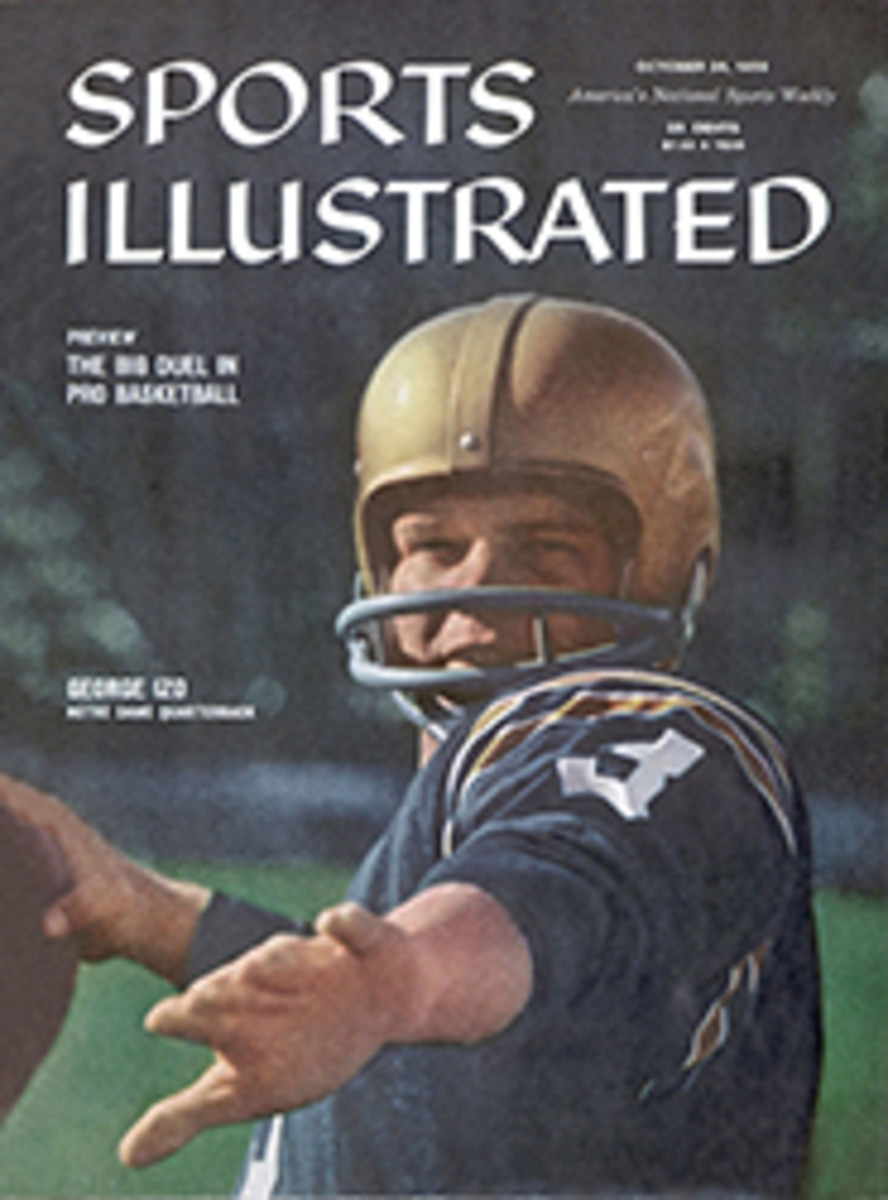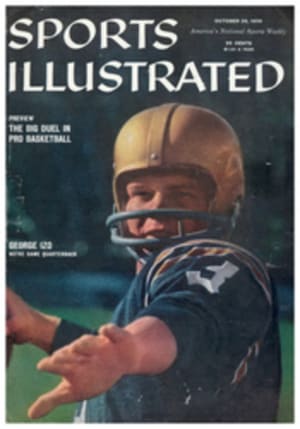
HERE COMES THE BIG FELLOW AT LAST
Framed by powerful arms that stretch 91 inches from fingertip to finger tip, one massive hand cradling the basketball as if it were a small grapefruit, the long, glistening torso giving evidence of his great total height, Wilt Chamberlain prepares to fire a one-hander (opposite) as he works out for his professional debut with the Philadelphia Warriors this week. It is a sight that brings shudders to rival camps around the National Basketball Association.
The best guess is that Wilt is 7 feet 2 inches tall. It is a guess, because there has never been an official, public measurement of this giant of a man. But there have been taller basketball players in recent years, and it is not Wilt's height alone that inspires fear and respect among prospective opponents. The important thing is that he is also a strong, fast, well-coordinated athlete. Consider the following: he has run the quarter mile in 49 seconds flat, bettered 6 feet 7 in the high jump, put the shot 51 feet, can lift 265 pounds in the clean-and-jerk and 210 in the military press. For none of these feats did Chamberlain prepare himself through normal training; they were casual, offhand achievements by an athlete who has always devoted his free time and effort to basketball.
As a teen-age boy he was already a fine player at Philadelphia's Overbrook High, where he set all manner of scoring and rebounding records. In his first game as a collegian at Kansas, he blocked a dozen shots and scored 52 points against a 6-foot-10 opponent who said afterward: "He made me feel like a little boy out there." In preseason exhibition games thus far against NBA teams, his performances have brought similar comment. St. Louis' Clyde Lovelette, 6 feet 9 and one of the best shooters in the game, says: "A small man like me doesn't have much chance with Wilt. He's the toughest offensive pivot man in the league right now and he hasn't played his first official game." Much of Chamberlain's value to a team is obvious, even to nonbasketball fans. But a great deal more can be simply described. Because of his quickness, reach and great spring, he is a constant threat to all rival players, not just the man he is assigned to guard. The best of opposing shooters must carefully note where Wilt is before firing or risk having the ball batted clear of the basket. His own teammates, therefore, can often play their men loosely and gamble on stealing the ball because Chamberlain is sure to be around to help them if they fail. This is a luxury that players for the Boston Celtics have enjoyed for several years now, because the great Bill Russell performs a similar function on that team.
Inevitably, comparisons between the two men—Russell and Chamberlain—were being made by fans, coaches and players even before Philadelphia and Boston met for the first time. Lovelette and Minneapolis' Jim Krebs, who have faced both, agree that Wilt is the better on offense. On defense, Krebs says, "I think Russell has better timing. He's not afraid to commit himself because he can recover and still block anything you put up."
Boston's Bill Sharman says, "Wilt will be great, but he may turn out to be the best thing that's happened to our team. We don't know, and Russell doesn't really know himself, just how good he can be. He's never been challenged this way. Wilt will push him to his limit."
Chamberlain, of course, has never been seriously challenged either. He has worked hard in training, carefully absorbing all he has to learn about pro-style basketball, obviously determined to live up to the advance notices which say he can be the best player the game has yet produced. His own opinion: "I don't think I have any disadvantages [as a pro] that time won't take care of. I don't plan to do anything particular about Russell or anyone else. I'm just doing everything I can to be ready for everybody. I'm playing them all alike. And they all better be mean."
MAN ON A POGO STICK
John Green will try to correct the one flaw in the armor of the New York Knickerbockers—inconsistency at the center post. A mere 6 feet 5, Green can rebound like a man on a pogo stick, but whether he also can put the ball in the basket with the regularity demanded of pros is the big question. On the answer rests the Knicks' strategy for the season and likely their chances of winning a berth in the playoffs.
LITTLEST LEADER
Smallest man in pro ball at 5 feet 10, Slater Martin is the mainspring that makes the St. Louis Hawks tick. He is also 34 years old and now takes days instead of hours to recover from minor injuries. When he was hurt last year the Hawks were knocked out of the playoffs by a Minneapolis team they had previously beaten eight times in 12 games. He is the clearest proof that good team play requires a strong leader.
NOT ROUGH—UNLESS
Handsome Rookie Bailey Howell, an all-American-boy type who was an All-America at Mississippi State, is the Detroit Pistons' bright hope—if he can handle the rough front-courtmen lying in wait around the league. Says he: "I'm not going to let them push me around, you know. But I'm not going to have a fit about it, you know? I don't want to say too much, but I won't play rough unless they do." They will.
QUAKER CITY'S TALL DREAM
For many Philadelphians, Wilt Chamberlain already looms larger than the statue of William Penn atop City Hall. Not quite as tall, he often appears so to rival players when he blocks their shots. He is known by many names on this city's playgrounds, where he learned to play basketball—The Stilt, The Dipper, Dippy and just plain Willie—but to the Philadelphia Warriors he is simply a very big dream come true.
BANKRUPTCY INTO SOLVENCY
Elgin Baylor's importance to the Minneapolis Lakers can be deduced from one incident. Last month, while Baylor was on duty with the Army at Fort Sam Houston, all the rest of the Lakers flew to Texas to practice with him, on the reasonable theory that there was no sense in practicing without him. Last year, in his rookie season, he brought Minneapolis from last place and bankruptcy to second place and solvency.
LIKE HAM AND EGGS
A perfect mesh of talent and temperament, of guile and power, Boston's Bob Cousy and Bill Sharman have made up the best backcourt in basketball for eight straight seasons. They may be at their peak or they may be beginning to slow down; whichever is true, another world title for Boston hangs in the balance. Bob is 31, Bill 33, in a game that penalizes a man severely for the slightest dimming of reflexive speed.
SHOOTING TWOSOME
The man with the least hair in basketball (George Yardley) and the man with the most (Dolph Schayes) are the most potent scoring pair in the NBA. Between them, too, they give Syracuse every shot in the book and should give rivals a merry chase for high-point honors. Though veterans, they are together for the first full season, a leavening of ripe experience on a team composed largely of fast, eager youngsters.
LONESOME JACK
Jack Twyman is apparently doomed to wait for the day Oscar Robertson finally gets around to joining the Royals before he'll have a teammate worthy of his mettle. Certainly Jack is the only Royal player who could win a position on any other club in the league—which is one way of saying that this team will be lucky to do as well as it did last year. That record was, sadly: won 19, lost 53—poorest in both divisions of NBA.
PHOTO
JAMES DRAKE
COCKING AN EYE nearly at a level with the basket, Wilt fires a practice jumper.
EIGHT ILLUSTRATIONS

